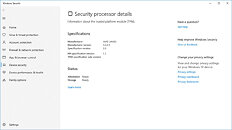Friday, June 25th 2021

Thanks to Windows 11, Scalpers Buy Out Add-on TPM 2.0 Modules
Most modern PC platforms include an fTPM (firmware trusted platform module) of some form. Those that don't, have a TPM 2.0 compatible header on the motherboards. Microsoft's requirement of a hardware TPM for Windows 11 has scalpers go after add-on TPMs, which are typically priced around $20, but now marked up to $100, according to price-tracking by Shen Ye, a senior HTC VIVE exec, who has been tracking prices of add-on TPMs on Twitter.
Scalpers possibly anticipate a rush of ill-informed buyers out for add-on TPMs, who haven't spent 5 minutes digging through their UEFI setup programs for the fTPM toggle. Below is a screenshot of a Ryzen 7 2700X-based machine, paired with an AMD B450 chipset motherboard (a platform from 2018), with its fTPM toggle turned on. The PC now meets Windows 11 system requirements. Windows 11 uses hardware TPMs for secure storage of credentials. "Microsoft, can you not impose a TPM requirement during a silicon shortage? Especially considering most desktop motherboards support TPM only as a purchasable accessory," Shen Ye tweeted.
Source:
Shen Ye (Twitter)
Scalpers possibly anticipate a rush of ill-informed buyers out for add-on TPMs, who haven't spent 5 minutes digging through their UEFI setup programs for the fTPM toggle. Below is a screenshot of a Ryzen 7 2700X-based machine, paired with an AMD B450 chipset motherboard (a platform from 2018), with its fTPM toggle turned on. The PC now meets Windows 11 system requirements. Windows 11 uses hardware TPMs for secure storage of credentials. "Microsoft, can you not impose a TPM requirement during a silicon shortage? Especially considering most desktop motherboards support TPM only as a purchasable accessory," Shen Ye tweeted.


263 Comments on Thanks to Windows 11, Scalpers Buy Out Add-on TPM 2.0 Modules
You can read about these protection techniques at the Microsoft article linked below...
Customize exploit protection | Microsoft Docs
www.microsoft.com/en-us/windows/windows-11-specifications
Btw: NTLite is a very good tool to create your own Win11 as soon as the final version is out at the end of this year. I´m using it for Win10 since many years and throw out everything that i don´t want from MS:
www.ntlite.com/
I imagine that some motherboards do not expose the option to enable it, though.
Still, it looks like this is indeed going to cause quite a bit of confusion.
When you go back in the OS it will be disabled. This will kill TPM and vPRO
This has worked on every dell Ive cone acrkss in the past 2 decades...cant sspeak for other pkatgorms though and most of the machines were precisions, latitudes and servers...not home versions like vostro.
Judging by outcry against "Microsoft Espionage" via damned Microsoft account and hysteria against TPM, I assume those who commented are using some very special OS on their smartphone?
Or you all using Android and iOS, have there Facebook, proper Google and Apple account (because you have to) and now you just fall into hysteria because you can?
If Windows is so unimportant, go install Linux and stop babbling about it... For Christ sake, every second post is about "I am switching to Linux, Linux is great, Linux, Linux...", and very few about subject.
And, finally, Microsoft will surely force TPM requirements only on Pro and upper versions, Home versions will be left without it, because it is not in their interest to slow down upgrade - quite contrary, they want as many people as possible, as fast as possible, to switch to 11...
It's like saying "everything will be ok as long as we write a perfect, flawlwess, bug free program."
That never happens. And while you can patch software easily, hardware is... not as easy.
option 1: dTPM = Discrete TPM module plugged into your mobo choosing this setting disables fTPM
option 2: fTPM = AMD's built in TPM2.0 compliant module
If it's set to option 1 then choose option 2 save and reboot once into windows rerun the health ap and it should tell you YES instead of NO for being able to run Windows 11
You'll also find a new Device listed under Security Devices in Device Manager like this